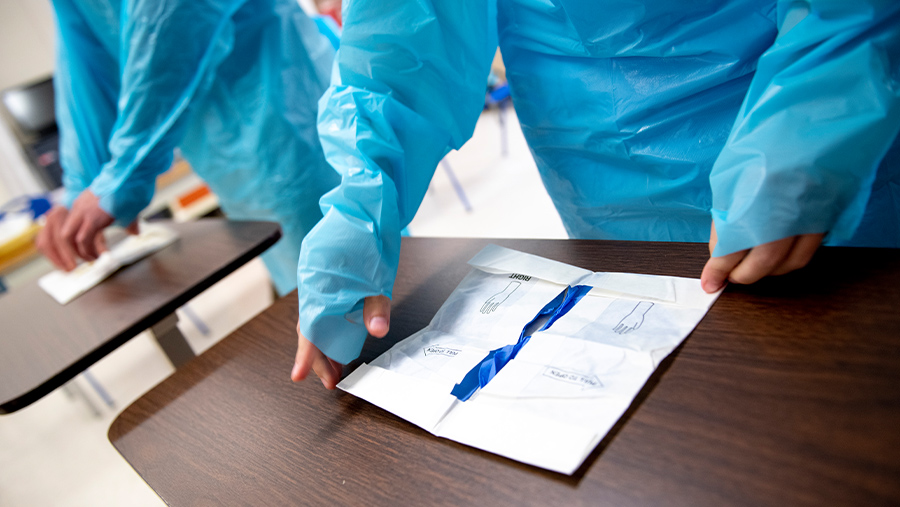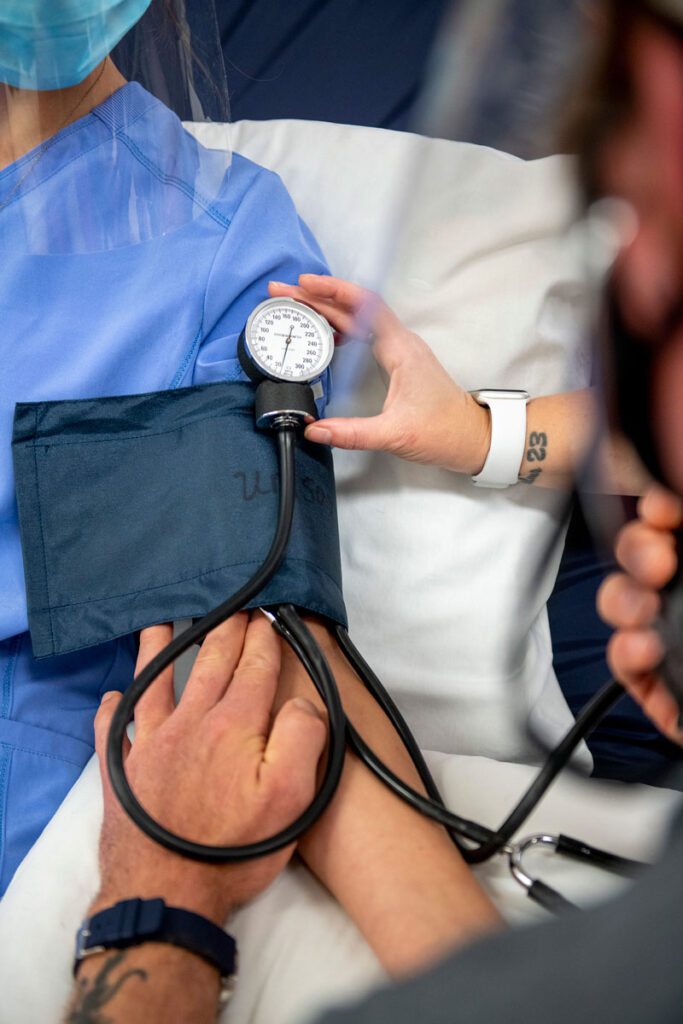
Evidence in Practice
Interlibrary Loan supports healthcare professionals around the world
The worldwide response to the COVID-19 pandemic brought questions about public health to the forefront. Conversations about healthcare, hospitals and healthcare workers proliferated news networks and social media. The early days of the COVID-19 pandemic also raised questions about information: where do we find it? How can we trust it? How do we get access to it?
The intersection of healthcare and information underlies public health campaigns, patient care and ongoing research. But, people outside of hospitals might be surprised to learn about a critical service that connects healthcare providers to information: medical libraries.
“[One of] the main things folks don’t realize is that libraries in hospitals actually exist!” says Heather Kemp, a medical librarian at Maine Medical Center. Located in Portland, MMC is the state’s largest medical center. It’s a teaching hospital with a large residency program and a biomedical research center, the Maine Medical Center Research Institute, that conducts ongoing research and clinical trials.
Kemp is one of four librarians at MMC. Her patrons include clinicians, nursing staff and employees of both MMC and its larger network, MaineHealth. Services at the medical library include research assistance, document delivery and interlibrary loan, and teaching classes.
Like their counterparts at academic or public libraries, medical librarians help connect their patrons to relevant, reliable information resources. With the prevalence of online information, including misinformation, Kemp says the awareness of the role of medical libraries is especially important.
“In healthcare, accurate, current, peer-reviewed information is critical to provide the best in patient care and dissemination of correct information to the public at large. We have seen this most recently with the COVID-19 pandemic.”
Finding the right resources is one challenge, but accessing those resources is another. No library can own every journal or database, and it’s common for research pursuits to reach beyond a library’s immediate collection. In those cases, librarians like Kemp can lean on a global network of libraries through interlibrary loan.
Interlibrary loan is a critical service for researchers and students across the world. When patrons need a resource their library doesn’t own, they can borrow from libraries that might have larger collections or different priorities for their collection.
“Interlibrary Loan via Fogler and all of the libraries that we work with are instrumental in supporting our patrons,” says Kemp. “They count on the information that they know we can provide for them, and if we do not have access to this information, it gives us confidence to know that Fogler will be able to provide what we need.”
With ILL service, Fogler Library is a net lender—the library loans more items than it borrows. Medical libraries are the most frequent recipient of interlibrary loans from Fogler. In the past year, the library loaned just under 10,000 items to nearly 800 different medical libraries and healthcare organizations located in all fifty states and Canada.
Still, interlibrary loan plays a major role in research at UMaine, where a wide variety of research pursuits requires the library to borrow materials from other libraries. The reciprocity between libraries connects patrons to information they otherwise wouldn’t be able to access.
The vast majority of items requested by medical and healthcare librarians are electronic articles, which means Fogler’s ILL staff can process and deliver those very quickly. When delivering electronic materials through ILL, Fogler Library’s average response is just over one hour.

In nearly 40 years as a medical librarian, Margaret Cobb has seen a fair number of changes in the technology and tools librarians use, but interlibrary loan has been a consistent foundation of the support she provides her patrons. The digital age, however, has made it easier for libraries to support each other.
“When I started out, you typed up a form and mailed it,” says Cobb. “The average turnaround time was two weeks. In our digital environment, it’s very rapid, and with patient care that’s crucial. For healthcare, it’s essential that we have an interlibrary loan network that we can depend on.”
Cobb is the manager of library services for Novant Health, a not-for-profit healthcare system with locations in North Carolina, Virginia, South Carolina and Georgia. Cobb’s patrons, primarily nurses and physicians, use library services for a range of needs from patient care to ongoing research.
“Our organization does clinical research, and we have a very active nursing research group,” says Cobb. “It’s amazing the things they do that impact patient care right at the bedside. We also try to support leaders as well with business and leadership materials. So it is really a mix.”
The mix of information needs—from clinical research to patient care and organizational improvements—is common for medical libraries. Access to relevant, reliable information underpins evidence-based practice, an approach to healthcare where providers continuously assess their practices in light of the best research evidence available. Medical librarians play a critical role in helping providers locate and access the evidence they need to make those decisions.
“There’s always ongoing quality improvement and evidence-based practice work going on,” says Eloise Flood, a librarian at the Children’s Hospital of Philadelphia. “This can range from direct clinical questions, like how best to manage a particular condition in a specific patient population, to ones that are much more organizationally focused.”
Flood and two other librarians were hired by the Children’s Hospital of Philadelphia in 2019 to set up an online library for clinicians and staff. Her most common patrons are in the Nursing and Clinical Care Services Department at the hospital, including nurses, dietitians, respiratory therapists, child life specialists and others.
While they’ve worked to grow the library’s collection, Flood says interlibrary loan has been a lifeline.
“The digital age has made us all more aware of just how much research is being done worldwide,” says Flood. “There are hundreds of thousands, if not millions, of new publications every year. Interlibrary loan is a vital part of library services—in particular medical library services, where access to the very latest research is so important.”
In the past twenty years, libraries have undergone a rapid technological shift, both in terms of the resources they offer and the tools they use to deliver those resources. Online resources such as e-journals and databases give patrons 24-hour access to the resources they need.
But “online” doesn’t mean “freely available.” While some journals publish open-access content that’s available to anyone, the vast majority of published journal content is behind a paywall. In many fields, including medicine, information needs trend toward published research most often found in journals.
The substantial cost of online journal content means that libraries make purchasing decisions based on the needs of their patrons. Fogler Library’s collection reflects the research and academic focuses of University of Maine students and faculty.
Resources needed for UMaine programs—such as nursing, biology, molecular and biomedical sciences, communication sciences and disorders and others—often overlap with the information needs of physicians, nurses, researchers and hospital administrators. And while Fogler doesn’t purchase resources specifically to support medical libraries, its collection still benefits those libraries because of Fogler’s ILL service.
To request materials from Fogler or other libraries, medical librarians use DOCLINE, a system provided by the National Library of Medicine. DOCLINE helps librarians and researchers access biomedical literature available through libraries in the Network of the National Library of Medicine. DOCLINE allows medical librarians to quickly request information resources that their library doesn’t own. It also functions as a delivery platform for libraries to provide access to the requested resources.
But for that to happen, libraries need to keep their DOCLINE listings up to date with their collections. Otherwise, the lending library would never receive the request because they wouldn’t appear to have the particular resource another library needs.
Cataloging staff at Fogler Library have to input individual journal titles and databases that the library owns to DOCLINE. Staff also need to regularly update listings as the library adds or removes subscriptions. The ongoing data entry and management makes Fogler Library’s collection accessible to medical libraries throughout the world.
Dramatic depictions of healthcare workers are easy to find in movies and television. But, the more accurate picture, says Eloise Flood, is focused on incremental improvements—the evidence-based practice—that move healthcare forward.
“I think people think of hospital librarians as rushing to get the latest research articles for the physicians who are faced with a knotty case or a new disease,” says Flood, “and there certainly is some of that.”
“But much of what I do day-to-day is help nurses find out if someone has written about a better way to get heights and weights from children who won’t stand still or help a play therapist find articles about the best way to configure a hospital play space to ensure both safety and a fun factor.”
By connecting healthcare providers to reliable information, librarians and libraries contribute to the ongoing improvement of patient care and medical practice. But, the search for evidence often extends beyond what one library can provide. In those cases, the collaboration between libraries around the world gives patrons the opportunity to continue asking questions and seeking answers.
As Heather Kemp explains, that kind of collaboration is part of the fundamental mission of libraries.
“The nature of medical libraries and libraries in general is close-knit,” says Kemp. “We are supportive of each other, regardless of what type of library we may work in. For all librarians, the ultimate goal is providing the best service for whatever type of patron you may have.”
This story was first published in the 2020 issue of the Raymond H. Fogler Library Magazine.
